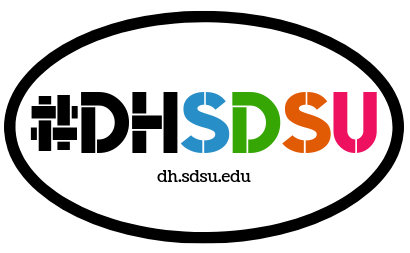Twine is a free and open-source tool for making interactive fiction, games, and hypertext. Does not require programming knowledge. Is flexible for creating all sorts of interactive products. Has been used at SDSU for classes on creative and critical writing.
Tutorials:
- Start here: watch the how-to-use Twine tutorials (they are all a bit different, so one might appeal to you more than another one):
- Step-by-step introductory guide to using Twine, created by SDSU alum Kristin Herr (for a tools workshop in 2019)
- Step-by-step guide made in Twine, created by SDSU alum and English MA Jared Zeiders (for a tools workshop in 2020)
- Step-by-step introductory guides created by former SDSU English professor Adam Hammond: “A Total Beginner’s Guide to Twine”
- Youtube tutorials
- Then, watch the tutorial on how to use Twine to create interactive stories! This module assumes a basic understanding of how to use Twine and builds upon it for more creative use. Created by Tina Lumbis, MFA in Creative Writing and former DH Center Programs Assistant.
- New for Spring 2021: The Digital Humanities Center has been busy creating Twine Tutorials covering a range of intermediate concepts, including variables, enchantment, and cascading style sheets (CSS). Plus, a new mini-tutorial on conditional statements, released June 2021. Created by Cathy Qiu, Digital Humanities Center Assistant.
Sample Student Project & Lesson Plan used to produce it
Project: Katie Chestnut used Twine to produce a creative-critical interactive essay inspired by and conversing with Helene Cixious’ seminal feminist essay, “The Laugh of the Medusa” (1975). Chestnut’s “Medusa’s Laughter” (see movie file) was produced for Professor Jessica Pressman’s ENG 563: “Cyberfeminism” class (Fall 2017).
Assignment: Creative-Critical Intervention (10% each, 30% total) These short (3-4 page) writing assignments allow you to explore the topic of cyberfeminism in creative and media-specific ways. You will respond to a text, presenting an argument about it, but you are free to do so in creative ways: you can write a poem or use a digital tool to remix a text or present your response. You will be graded on content and format of your response/intervention. Form and format should support your content (argument); “the medium is the message” as Marshall McLuhan argues. You can rewrite these interventions for a better grade. Revisions are due before the next deadline for a creative-critical intervention. (To see full syllabus from Pressman’s ENG 563: “Cyberfeminism” class, from which this assignment is taken, click here)
Faculty point of contact:
- Jessica Pressman (English and Comparative Literature) can help you design assignments using Twine and provide examples of student projects created in Twine as well as born-digital literature made in Twine. jpressman@sdsu.edu
- Pam Lach (DH Librarian) can support use of Twine. plach@sdsu.edu
